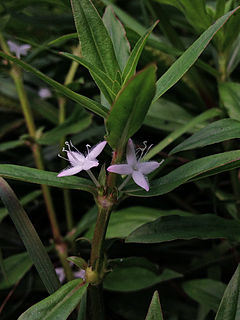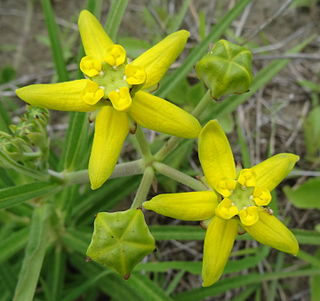
Diodia is a genus of flowering plants in the Rubiaceae family. It was described by Carl Linnaeus in 1753. The genus is found from southern and eastern United States, South America, Central America, Mexico, the West Indies and tropical Africa.

Lepismium is a genus of mostly epiphytic cacti, with a dozen species. They are found in tropical South America.

Bignonia is a genus of flowering plants in the catalpa family, Bignoniaceae. Its genus and family were named after Jean-Paul Bignon by his protégé Joseph Pitton de Tournefort in 1694, and the genus was established as part of modern botanical nomenclature in 1753 by Carl Linnaeus.

Aneilema is a genus of monocotyledonous plants of approximately 60 species. The vast majority of the species are native to sub-Saharan Africa, but a few are found in Oceania and one, Aneilema brasiliense, is from South America. It is the third largest genus in the family Commelinaceae after Commelina and Tradescantia, and it is one of only six genera in the family to occur in both the Eastern Hemisphere and the Western Hemisphere.
Calycosiphonia is a genus of flowering plants in the Rubiaceae family. It is native to tropical Africa from Ghana to Sudan to Mozambique.
Hunteria is a genus of plant in family Apocynaceae first described as a genus in 1824. It is native to Africa and to South and Southeast Asia.
- Hunteria ballayiHua - Central African Republic, Republic of Congo, Cameroon, Gabon
- Hunteria camerunensisK.Schum. ex Hallier f. - Republic of Congo, Cameroon, Gabon
- Hunteria congolanaPichon - Republic of Congo, Zaïre, Kenya
- Hunteria densifloraPichon - Zaïre
- Hunteria ghanensisJ.B.Hall & Leeuwenb. - Ivory Coast, Ghana
- Hunteria hexaloba(Pichon) Omino - Gabon
- Hunteria macrosiphonOmino - Republic of Congo, Gabon
- Hunteria myrianthaOmino - Zaïre
- Hunteria oxyanthaOmino - Republic of Congo, Zaïre, Gabon
- Hunteria simii(Stapf) H.Huber - Guinea, Ivory Coast, Liberia, Sierra Leone
- Hunteria umbellata(K.Schum) Hallier f. - W + C Africa from Senegal to Zaïre
- Hunteria zeylanica(Retz.) Gardner ex Thwaites - Somalia, Kenya, Tanzania, Mozambique, S China, India, Sri Lanka, Andaman & Nicobar Islands, Indochina, W Malaysia, Sumatra
Oxyanthus is a genus of plant in family Rubiaceae. It contains the following species :
Pleioceras is a genus of plant in family Apocynaceae, first described as a genus in 1888. It is native to tropical Africa.
Hyperacanthus is a flowering plant genus in the family Rubiaceae, occurring on Madagascar and nearby southern Africa, approximately from Mozambique to the southernmost parts of the continent.
Zonotriche is a genus of African plants in the grass family.
- Zonotriche brunnea(J.B.Phipps) Clayton - Zaïre
- Zonotriche decora(Stapf) J.B.Phipps - Zaïre, Tanzania, Angola, Zambia
- Zonotriche inamoena(K.Schum.) Clayton - Zaïre, Tanzania, Angola, Zambia, Malawi, Mozambique, Zimbabwe

Enteropogon is a genus of tropical and subtropical plants in the grass family. It is widespread across many parts of Asia, Africa, Australia, the Americas, and various islands.
- Enteropogon acicularis(Lindl.) Lazarides - curly windmill grass, large windmill grass, umbrella grass - Australia
- Enteropogon barbatusC.E.Hubb. - Ethiopia, Somalia, Kenya
- Enteropogon brandegeei(Vasey) Clayton - Baja California, Baja California Sur
- Enteropogon chlorideus(Presl) Clayton - buryseed umbrella grass, verdillo cacahuatoide - Arizona, Texas, Mesoamerica
- Enteropogon coimbatorensisK.K.N.Nair, S.K.Jain & M.P.Nayar - India
- Enteropogon dolichostachyus(Lag.) Keng - Yemen, Oman, Afghanistan, Indian Subcontinent, Indochina, southern China, Philippines, Malaysia, Indonesia, New Guinea, northern Australia, Micronesia
- Enteropogon longiaristatus(Napper) Clayton - Tanzania
- Enteropogon macrostachyusMunro ex Benth. - bushrye - Zimbabwe, Mozambique, Limpopo, Mpumalanga, Gauteng, North West Province
- Enteropogon minutusLazarides - northern Australia
- Enteropogon mollis(Nees) Clayton - Central America, West Indies, northern South America, Galápagos
- Enteropogon monostachyusSchum. - Somalia, Tanzania, Mozambique, Zambia, Swaziland, KwaZulu-Natal, Mpumalanga, Limpopo, India, Sri Lanka, Myanmar
- Enteropogon paucispiceus(Lazarides) B.K.Simon - Queensland
- Enteropogon prieurii(Kunth) Clayton - drier parts of Africa; Saudi Arabia, Yemen, India
- Enteropogon ramosusB.K.Simon - tussock umbrella grass - Australia
- Enteropogon rupestris(J.A.Schmidt) A.Chev. - drier parts of Africa
- Enteropogon seychellarumBenth. - Somalia, Kenya, Tanzania, Mozambique, Zambia, Madagascar, Seychelles, Aldabra
- Enteropogon unispiceus(F.Muell.) Clayton - Taiwan, Queensland, New South Wales, Cook Islands
Hylebates is a genus of African plants in the grass family.
- Hylebates chlorochloe(K.Schum.) Napper - - Tanzania, Kenya
- Hylebates cordatusChippind. - Tanzania, Mozambique, Zambia, Zimbabwe
Cuviera is a genus of flowering plants in the Rubiaceae family native to tropical Africa. It was originally described by Augustin Pyramus de Candolle in 1807 and is named after the French naturalist Georges Cuvier.

Cola is a genus of trees native to the tropical forests of Africa, classified in the family Malvaceae, subfamily Sterculioideae. Species in this genus are sometimes referred to as kola tree or kola nut for the caffeine-containing fruit produced by the trees that is often used as a flavoring ingredient in beverages. The genus is related to the South American genus Theobroma, or cocoa. They are evergreen trees, growing up to 20 m tall, with glossy ovoid leaves up to 30 cm long and star-shaped fruit.
Cremaspora is a genus of flowering plants in the Rubiaceae family. It is the only genus in the tribe Cremasporeae. It was described by George Bentham in 1849. The genus is widespread across much of sub-Saharan Africa from Senegal to Tanzania and south to Mozambique and Zimbabwe, in addition to Madagascar, Comoros, and Cape Verde. There are, however, only two currently recognized species.

Markhamia is a genus of flowering plants in the Bignoniaceae family. The genus is named after Clements Markham.
Siphonochilus is a genus of plants native to sub-Saharan Africa.
- Siphonochilus aethiopicus(Schweinf.) B.L.Burtt - widespread from Ethiopia west to Sierra Leone and south to South Africa
- Siphonochilus bambutiorumA.D.Poulsen & Lock - Zaïre
- Siphonochilus brachystemon(K.Schum.) B.L.Burtt - eastern Africa from Sudan to Mozambique
- Siphonochilus kilimanensis(Gagnep.) B.L.Burtt - Mozambique
- Siphonochilus kirkii(Hook.f.) B.L.Burtt - eastern and central Africa from Sudan and Central African Republic south to South Africa
- Siphonochilus longitubusLock - Zambia
- Siphonochilus nigericus(Hutch. ex Hepper) B.L.Burtt - Nigeria, Ghana
- Siphonochilus parvusLock - Tanzania, Zambia, Malawi
- Siphonochilus pleianthus(K.Schum.) Lock - Zaïre, Angola, Zambia
- Siphonochilus puncticulatus(Gagnep.) Lock - Zaïre, Angola, Zambia
- Siphonochilus rhodesicus(T.C.E.Fr.) Lock - Tanzania, Zambia, Malawi, Zaïre

Stathmostelma is a genus of plants in the Apocynaceae, first described as a genus in 1893. It is native to Africa.
Glossostelma is a plant genus in the family Apocynaceae, first described as a genus in 1895. It is native to Africa.
- Glossostelma angolenseSchltr. - Angola
- Glossostelma brevilobumGoyder - Zaïre, Burundi, Tanzania, Malawi
- Glossostelma cabrae(De Wild.) Goyder - Zaïre
- Glossostelma carsonii(N.E.Br.) Bullock - Gabon
- Glossostelma ceciliae(N.E.Br.) Goyder - Zimbabwe, Mozambique
- Glossostelma erectum(De Wild.) Goyder - Zaïre
- Glossostelma lisianthoides(Decne.) Bullock - Angola
- Glossostelma mbisienseGoyder - Tanzania
- Glossostelma nyikenseGoyder - Malawi, Zambia
- Glossostelma rusapenseGoyder - Zimbabwe
- Glossostelma spathulatum(K.Schum.) Bullock - Angola
- Glossostelma xysmalobioides(S.Moore) Bullock - Angola

Raphionacme is a plant genus in the family Apocynaceae, first described as a genus in 1842. The genus is found primarily in Africa, with one species on the Arabian Peninsula.










